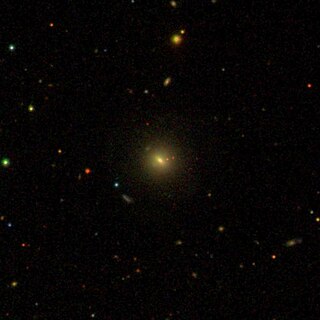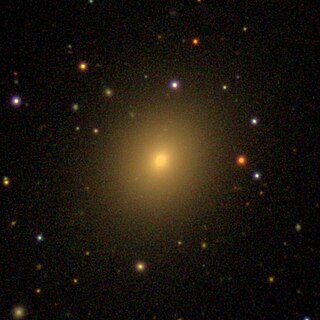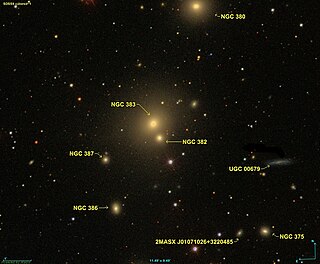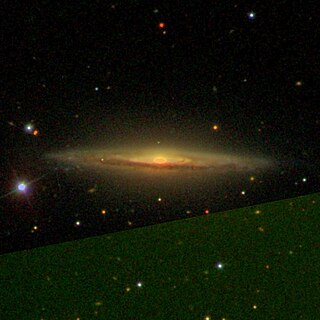
The Pinwheel Galaxy is a face-on, unbarred, and counterclockwise spiral galaxy located 21 million light-years from Earth in the constellation Ursa Major. It was discovered by Pierre Méchain in 1781 and was communicated that year to Charles Messier, who verified its position for inclusion in the Messier Catalogue as one of its final entries.

NGC 4125 is an elliptical galaxy in the constellation Draco. It was discovered on 4 January 1850 by English astronomer John Russell Hind.

NGC 39 is an unbarred spiral galaxy in the constellation Andromeda. Its velocity with respect to the cosmic microwave background is 4529 ± 25 km/s, which corresponds to a Hubble distance of 217.9 ± 15.3 Mly (66.80 ± 4.69 Mpc). It was discovered by German-British astronomer William Herschel on 2 November 1790.

NGC 1725 is a lenticular galaxy in the constellation Eridanus. The galaxy is listed in the New General Catalogue. It was discovered on November 10, 1885 by the astronomer Edward Emerson Barnard.

NGC 52 is an edge-on spiral galaxy in the constellation Pegasus. It was discovered on September 18, 1784, by William Herschel. He described it as "very faint, small, extended."

NGC 462 is an elliptical galaxy located in the Pisces constellation. It was discovered by Albert Marth on 23 October 1864. Dreyer, creator of the New General Catalogue, originally described it as "extremely faint, very small, stellar". The word stellar clearly suggests an initial misidentification of NGC 462 as a star.

NGC 777 is an elliptical galaxy in the constellation of Triangulum. It was discovered by William Herschel on September 12, 1784. It has a weak active nucleus of type Seyfert 2 or LINER 2, implying that the central region is obscured. It may be an outlying member of galaxy cluster Abell 262.

NGC 382 is an elliptical galaxy located in the constellation Pisces. Its discovery has been credited to William Parsons.

NGC 7029 is an elliptical galaxy located about 120 million light-years away from Earth in the constellation Indus. NGC 7029 has an estimated diameter of 129,000 light-years. It was discovered by astronomer John Herschel on October 10, 1834. It is in a pair of galaxies with NGC 7022.

NGC 684 is a spiral galaxy approximately 135 million light-years away from Earth in the constellation of Triangulum. It was discovered by William Herschel on October 26, 1786. Edward Swift, Lewis' son, found this galaxy again on 18 Jan 1890 while "searching for Swift's Comet." and it was reported as a new object in list IX-6.

NGC 1282 is an elliptical galaxy located about 230 million light-years away in the constellation Perseus. It was discovered by astronomer Guillaume Bigourdan on October 23, 1884. NGC 1282 is a member of the Perseus Cluster.

NGC 3873 is an elliptical galaxy located about 300 million light-years away in the constellation Leo. The galaxy was discovered by astronomer Heinrich d'Arrest on May 8, 1864. NGC 3873 is a member of the Leo Cluster.

NGC 860 is an elliptical galaxy located in the constellation Triangulum. It is about 410 million light-years from the Milky Way. It was discovered by the French astronomer Édouard Stephan on 18 September 1871.

NGC 2803, also known as PCG 26181, is an elliptical or lenticular galaxy in the zodiac constellation Cancer. It was discovered March 21, 1784, by William Herschel. It is interacting with NGC 2802.

NGC 1332 is an almost edge-on elliptical galaxy located in constellation of Eridanus. Situated about 70 million light years away, it is a member of the Eridanus cluster of galaxies, a cluster of about 200 galaxies. It is also the brightest member of the NGC 1332 Group. It was discovered by William Herschel on 9 December 1784.

NGC 997 is an interacting galaxy in the constellation of Cetus. The galaxy was discovered by Albert Marth on 10 November 1863. It has a regularly rotating central molecular gas disk, containing a black hole of between 4 x 107 and 1.8 x 109 solar masses. Its speed relative to the cosmological background is 6,270 ± 45 km/s, corresponding to a Hubble distance of 92.5 ± 6.5 Mpc (~302 million ly).

NGC 7619 is an elliptical galaxy located in the constellation Pegasus. NGC 7619 and NGC 7626 are the dominant and brightest members of the Pegasus galaxy cluster. Both of them were discovered by William Herschel on September 26, 1785.

NGC 3613 is an elliptical galaxy in the constellation Ursa Major. It was discovered by the astronomer William Herschel on April 8, 1793. NGC 3613 is the center of a cluster of galaxies, and has an estimated globular cluster population of over 2,000.

NGC 7503 is an elliptical galaxy in the constellation Pisces. It was discovered by the astronomer Albert Marth on September 2, 1864. It is the brightest galaxy in its cluster.

NGC 7501 is an elliptical galaxy located in the constellation Pisces. It was discovered on September 2, 1864 by the astronomer Albert Marth. It is a member of the Pegasus II cluster of galaxies. A radio source has been detected within one minute of arc of the position of NGC 7501.



















